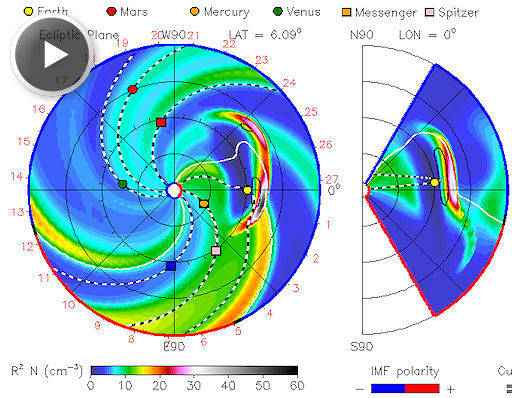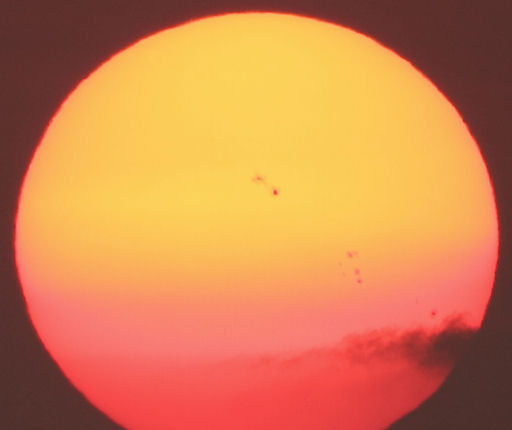Turn your cell phone into a field-tested satellite tracker. Works for Android and iPhone. | | |
M6-CLASS SOLAR FLARE: Sunspot 1261 unleashed another strong solar flare this morning--an M6-class flash at 1348 UT. Like yesterday's eruption from the same active region, this explosion propelled a CME in the general direction of Earth. ETA: August 5th. Stay tuned for additional analysis.
UPDATE: A listening station above the Arctic Circle in Norway reports ionospheric waves and VHF radio noise associated with today's M6-flare: their data.
INCOMING CLOUD: Yesterday's M1-class eruption from sunspot 1261 was observed by three spacecraft: SOHO, STEREO-A and STEREO-B. Using data from those three points of view, analysts at the GSFC Space Weather Lab have made a 3-dimensional model of the CME now en route to Earth. Click on the image to launch a computer-generated movie of the expanding cloud:

According to their work, the CME left the sun traveling 900 km/s and should reach Earth (denoted by a yellow dot in the simulation) on August 5th at 0300 UT plus or minus 7 hours. Another cloud produced by today's M-flare may be right behind it; stay tuned for movies of that one, too. Mild to moderate geomagnetic storms are possible when these CMEs arrive on August 5th and 6th. Aurora alerts: text, voice.
July 2011 Aurora Gallery
[previous Julys: 2010, 2009, 2008, 2007, 2006, 2005, 2004, 2003]
SPOTTED SUNSETS: During the recent years of deep solar minimum, observers of the sunset grew accustomed to a blank solar disk. News flash: The sunspots are back. "The sunset conditions of August 2nd were just right to show the massive sunspots AR1260, AR1261 and AR1263 to the casual observer who happened to glance at the sun for a brief few moments," reports Stephen W. Ramsden of Atlanta, Georgia. "You could even see the penumbra with the naked eye!" He had a camera handy and snapped this picture:

"The size and broiling movement of these sunspots just boggles the mind," he says. "You could fit every planet in the solar system with all of the known asteroids neatly inside the largest group...wow!"
Caution: Even when the sun is dimmed by low-hanging clouds or haze, focused sunlight can still damage your eyes. Do not look at the sun through unfiltered optics of any kind. A safely-filtered White Light Solar Observing System is the best way to monitor these great sunspots.
TODAY'S BONUS SHOTS: Flashing Solar Sail from Juha Peräsaari of Seinäjoki, Finland; Star-Grazing Comet from Gregg Ruppel of Ellisville, MO; Hot Heat! from Doug Zubenel of De Soto, Kansas; Electric Sunspots from C B Devgun SPACE of New Delhi, India;
2011 Noctilucent Cloud Gallery
[previous years: 2003, 2004, 2005, 2006, 2007, 2008, 2009]

